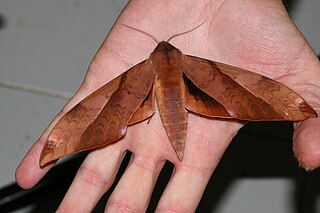
Agrius cingulata, the pink-spotted hawkmoth or sweetpotato hornworm, is a moth in the family Sphingidae. The species was first described by Johan Christian Fabricius in 1775.

Psilogramma increta, the plain grey hawkmoth, is a moth of the family Sphingidae.

The Sphinginae are a subfamily of the hawkmoths (Sphingidae), moths of the order Lepidoptera. The subfamily was first described by Pierre André Latreille in 1802. Notable taxa include the pink-spotted hawkmoth, being a very common and recognizable species, the death's-head hawkmoths of Silence of the Lambs fame, and Xanthopan morganii with its enormous proboscis.

Sphinx morio, the larch hawk moth or Asian pine hawkmoth, is a moth of the family Sphingidae. It is found in Russia, the Korean Peninsula, Japan and China.

Phyllosphingia is a monotypic moth genus in the family Sphingidae erected by Charles Swinhoe in 1897. Its only species, Phyllosphingia dissimilis, the buff-leaf hawkmoth, was described by Otto Vasilievich Bremer in 1861.

Sphingonaepiopsis is a genus of moths in the family Sphingidae.

Ambulyx moorei, the cinnamon gliding hawkmoth, is a moth of the family Sphingidae. The species was first described by Frederic Moore in 1858. It is found in Sri Lanka, southern and eastern India, the Nicobar Islands and Andaman Islands, Thailand, Vietnam, southern China, the Philippines, Malaysia, Singapore and Indonesia.

Clanis undulosa, the wavy velvet hawkmoth, is a moth of the family Sphingidae first described by Frederic Moore in 1879. The nominate subspecies is found in the southern Russian Far East, the Korean Peninsula and north-eastern China, as far as south and west as Shaanxi and Hebei. South from Sichuan (Baoxing), Hubei, Jiangxi (Guling) and Zhejiang, it is replaced by ssp. gigantea, which ranges west to Nepal and south, through Thailand and Vietnam, to Peninsular Malaysia.

Marumba cristata, the common striped hawkmoth, is a species of moth of the family Sphingidae. It is found from the Himalaya, through Nepal and north-east India, southern and central China to western Malaysia (Sundaland).

Sphingonaepiopsis gorgoniades, the Gorgon hawkmoth, is a moth of the family Sphingidae. The species was first described by Jacob Hübner in 1819. It is found from Croatia, Albania, Macedonia, central and southern Greece, eastern Bulgaria and Romania across southern Ukraine and the Crimea, southern Russia as far north as Kazan, the southern Urals and eastern Kazakhstan to Kyrgyzstan and Afghanistan. It has also been recorded from central and southern Turkey, Lebanon, Israel and western Jordan eastward across northern Iraq, the Caucasus, northern Iran to southern Turkmenistan.

Sphingonaepiopsis kuldjaensis, the Kuldja hawkmoth, is a moth of the family Sphingidae. The species was first described by Ludwig Carl Friedrich Graeser in 1892. It is found in eastern Kazakhstan, western Xinjiang province in China, eastern Uzbekistan, Tajikistan, Kyrgyzstan and eastern Afghanistan.

Sphingonaepiopsis nana, the savanna hawkmoth, is a moth of the family Sphingidae. The species was first described by Francis Walker in 1856. It is found from the Kerman Province, Hormozgan Province and Baluchistan in southern Iran and western Saudi Arabia to the southern Arabian Peninsula and eastern Africa to Natal, west to the Gambia.

Ampelophaga rubiginosa is a moth of the family Sphingidae. It was described by Otto Vasilievich Bremer and William (Vasilii) Grey in 1853. It is found from north-eastern Afghanistan, east around the southern margin of the Himalaya to Yunnan, then throughout China to the Russian Far East, the Korean Peninsula and Japan. It is also found south through Thailand and Vietnam to Sumatra and Peninsular Malaysia.

Polyptychus chinensis, the Chinese crenulate hawkmoth, is a moth of the family Sphingidae. It is known from China, Taiwan and the Ryukyu Archipelago.

Sphinx caligineus, the Chinese pine hawkmoth, is a moth of the family Sphingidae. It is known from Japan, north-eastern, eastern, central and southern China, South Korea, northern Thailand and southern Vietnam.

Smerinthulus perversa, the lichenous hawkmoth, is a species of moth of the family Sphingidae. It is known from Taiwan, Nepal, north-eastern India, northern Myanmar, south-western and southern China and Thailand.
Sphingonaepiopsis gurkoi, the Gurkoi hawkmoth, is a moth of the family Sphingidae. The species was first described by Tomáš Melichar and Michal Řezáč in 2013. It is found in Tajikistan where it has been recorded at elevations above 3,500 meters in mountain steppe areas. It is possibly also found in Mongolia.
Sphingonaepiopsis asiatica, the Kopet hawkmoth, is a moth of the family Sphingidae. The species was first described by Tomáš Melichar and Michal Řezáč in 2013. It is found in the Kopet-Dagh Mountains, along the border of northern Iran and southern Turkmenistan.















